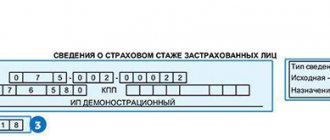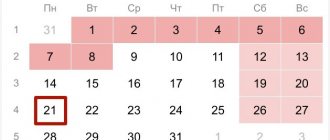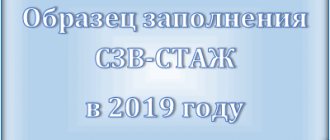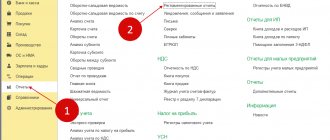You need to rely on the procedure for filling out SZV-STAZH
In section 3 of SZV-STAZH for each employee, you need to record the periods when he worked and when he did not work - he was on vacation, on sick leave, or absent for other reasons. Enter the start and end dates of each period in columns 6 and 7. For unworked periods, additionally indicate the code from the Classifiers in column 11. For example, DLOTPUSK - for paid leave, VRNETRUD - for sick leave, CHILDREN - for leave to care for a child up to one and a half years old (clause 2.3 of the Filling Out Procedure).
Please note: in the order of filling out the SZV-STAZH, approved by Resolution of the Board of the Pension Fund of the Russian Federation dated January 11, 2017 No. 3p, it is stated that the code “DLOTPUSK” must indicate all vacations. Thus, it is better for accountants to follow the official filling procedure and indicate the DLOTPUSK code for all types of paid leave. For other types of vacations there are other codes, for example:
- leave for parents to care for a child up to one and a half years old - code “CHILDREN”;
- leave for father or mother to care for a child from one and a half to three years - code “DLCHILDREN”;
- study leave – code “UCHOT LEAVE”;
- leave without pay – code “NEOPL”.
From when do the new rules apply?
The provisions approved by the Resolution of the Board of the Pension Fund of December 6, 2018 No. 507p apply from January 1, 2021. They must be followed when filling out information about experience for 2021. The deadline for submitting the SZV-STAZH reporting form for 2021 is March 1, 2021. Changes are also taken into account by policyholders who submit a report to the Pension Fund for 2021 on persons retiring this year. If errors are discovered in a report that has already been submitted, it is better for the policyholder to clarify the data independently by submitting an adjustment before the Fund discovers the false information.
Problem: Warning is issued
When specifying the code “DLOTPUSK”, the PFR verification program may issue a warning with code 20. However, the warning is not a basis for refusal to accept reports and in this case is caused by technical problems. That is, even if the program warns you about the inadmissibility of specifying the “DLOTPUSK” code, just don’t pay attention. The report for 2021 will be accepted without problems. There cannot be any fines for this, since the accountant is guided by the official procedure for filling out the SZV-STAZH. Let's assume that a person was on annual paid leave from June 5 to June 25, 2021. Then show the DLOTPUSK code in SZV-STAZH as follows:
For more information, see “SZV-STAZH for 2021: sample filling.”
Read also
28.02.2017
Do I need to show vacation in SZV-STAZH?
The process of filling out leave at SZV-STAZH depends on its type: regular, additional, maternity leave, etc.
The form and procedure for filling out the report were approved by Resolution of the Board of the Pension Fund of the Russian Federation No. 507p dated December 6, 2018 (hereinafter referred to as the Procedure). The regular annual paid vacation for employees working under normal conditions is not reflected in the report. Previously, such days were designated as “DLOTPUSK” and included in the report; from 2021, this is how days are designated for an employee working under special conditions.
Thus, annual leave in SZV-STAZH for a standard employee is not reflected, since it is part of the length of service and does not give the right to benefits and allowances; the policyholder pays contributions for it. Accordingly, for the purpose of assigning a pension, there are no differences between the period of work and paid rest time. All other types of vacation (unpaid, preferential, for pregnancy and childbirth, etc.) must be included in the report.
ConsultantPlus experts discussed how to fill out and submit the SZV-STAZH for 2020. Use these instructions for free.
The concept of “DLOTPUSK” in the form of SZV-experience
“DLOTPUSK” is a coded expression related to SZV-experience. It means the period of time during the reporting year that the employee spent on paid leave of any kind provided for in Art. 114, art. 115, art. 116 Labor Code of the Russian Federation.
Contrary to the popular belief that the code in question is relevant to apply for every case when a subordinate was on vacation, this is not so. The procedure for completing the SZV-experience form assumes that this code is used only once and is written at the end of the document, and both conditions are fulfilled at the same time. That is, in the form of SZV-experience “DLOTPUSK” should be the last line.
Based on the RF PP No. 3 dated January 11, 2017. “Information about the form SZV-experience”, “DLOTPUSK” should be used to encode all leaves. However, it is appropriate for accounting employees to be of the opinion that this code is relevant for paid rest periods for employees. In this case, other leaves should be coded as follows:
- leave due to pregnancy and childbirth - the designation “DECREE” is used;
- caring for a young child under 3 years of age – designation “CHILDREN”;
- leave for educational reasons - “UCHOTLEASE”;
- free holiday - "NEOPL".
Preparation of the SZV-experience report by vacations
A paper version of the SVZ-experience report is suggested only if the number of subordinates of a particular employer is less than 24 people. Based on Federal Law No. 27 of 04/01/1996, if the number of working citizens in an organization exceeds the specified figure, the only possible way to submit documentation is electronically.
Vacation data is indicated in the third part of the report. Thus, information about non-working periods of employees should be entered in column No. 11. This section ends with the column “DISTRIBUTION”.
In circumstances where an employee took several vacation periods per year, these facts are recorded in separate lines, and each such column is assigned its own record number. If several lines were used to complete the reporting period, then the serial number is recorded only in the first column.
Thus, the manager needs to be familiar with the procedure for compiling SZV reporting, especially in the part where information about employee leaves is recorded. In particular, he should find out what “DLOTPUSK” means in SZV-experience. This type of reporting is new, and therefore requires special attention when studying and understanding to become familiar with the details and nuances.
How to reflect an employee’s annual paid leave for 2021 in the SZV-STAGE form?
» Question to an expert » Frequently asked questions » How to reflect an employee’s annual paid leave for 2021 in the SZV-STAZH form?
Question: How to reflect an employee’s annual paid leave for 2021 in the SZV-STAZH form?
Answer: If the employee worked under normal conditions, then periods of annual paid leave are not allocated.
Do not allocate annual leave for ordinary employees in SZV-STAZH, it is included in the period of work. With the DLOTPUSK code, reflect only some vacations of employees with special working conditions (clause 2.3.13 of the Filling Out Procedure).
The filling rules have been slightly clarified. For example, the code “DLOTPUSK” cannot be assigned to annual vacations under normal working conditions.
The code “DLOTPUSK” is entered when employees with special working conditions do not have additional tariff contributions. This code always goes along with codes for special working conditions. It is not used for annual leave under normal working conditions;
Clause 2.3.13 of the Resolution of the Board of the Pension Fund of the Russian Federation dated December 6, 2018 No. 507p “On approval of the form “Information on the insurance experience of insured persons (SZV-STAZH)”, the form “Information on the policyholder transferred to the Pension Fund of the Russian Federation for maintaining individual (personalized) records (EDV -1)”, forms “Data on the adjustment of information recorded on the individual personal account of the insured person (SZV-KORR)”, forms “Information on earnings (remuneration), income, amount of payments and other remunerations, accrued and paid insurance premiums, periods of labor and other activities counted in the insurance length of the insured person (SZV-ISH)”, the procedure for filling them out and the format of information and on the recognition as invalid of Resolution of the Board of the Pension Fund of the Russian Federation dated January 11, 2017 No. 3p” (hereinafter referred to as Resolution No. 507p).
Lot release
Add to "Wanted"
Current as of: February 14, 2021
In our consultations, we talked about the SZV-STAZH form, which policyholders must submit to the Pension Fund of the Russian Federation upon the employee’s retirement and at the end of the year, and also be given to the employee upon his dismissal. At the same time, it was noted that in column 11 “Calculation of insurance experience, additional information” of the SZV-STAZH form, the code of unworked periods is indicated, among others. One of these codes is “DLOTPUSK”. What does DLOTPUSK mean in SZV-STAZH?
It’s up to you to decide whether to always indicate “DLOTPUSK” when filling out the SZV-STAGE. If, for example, your accounting program automatically generated a report with “DLOTPUSK” periods, of which there may be several or they are not the last, there is no need to correct the report. After all, with such an indication of DLOTPUSK in SZV-STAZH, a warning when checking the report is the only thing that can alert you. But a warning is not an error. And this form of SZV-STAZH will be accepted by the Pension Fund.
After all, the main thing is that all periods of work for the policyholder are included in the insurance period. Periods of annual leave are automatically included in the insurance period. And even if the DISTRIBUTION for vacations was not indicated, the employee’s length of service will not be affected.
But if the vacation followed by dismissal began in 2021 and ended in 2021, you need to indicate DLOTPOSK. After all, the employee no longer had payments in 2017. And so that the employee’s seniority does not disappear, in 2021 it is necessary to mark DLOTPUSK for the period 01/01/2017 – XX.XX.2017 (date of dismissal).
Long-term admission to SZV-stazh - what is this code? – legal advice
When filling out the SZV-STAZH form, it is necessary to correctly reflect the regular annual vacations of employees in section 3. We will tell you in what cases the code “DLOTPUSK” is put in SZV-STAZH, what this means and how not to confuse this code with the codes of other vacations.
Codes for SZV-STAZH 2021 with decoding, period codes
— Business organization — Personnel — Codes for SZV-STAZH
The SZV-STAZH report includes the insurance period, as well as periods when the employee was on vacation. To correctly reflect information in it using SZV-STAZH codes, you must adhere to certain federal rules.
Where and by whom are SZV-STAZH reports submitted?
SZV-STAZH – a document that displays information about the employee’s vacation periods and insurance benefits paid. Reporting is submitted on the results of the past year until March 1st to the branches of the Pension Fund (PF). The report must be submitted to:
- Enterprises and their individual branches;
- IP.
Federal Law No. 27 of April 1, 1996 indicates that the document must be provided for all persons who work under the Labor Agreement in the form regulated by the legislative acts governing the reporting of the Pension Fund of Russia.
If employment agreements are signed, but no payments were made for the reporting period, the SZV-STAZH form is still filled out and submitted.
How to fill out SZV-STAZH
Requirements for filling out the form:
- Full name must be indicated using only the nominative case;
- Information and dates in the columns regarding the duration of the employee's work duties should be reflected only for the period during which the form was submitted.
In addition to them, there are some rules for filling out the sections that the SZV-STAZH form has.
Information about the policyholder
In the section it is necessary to indicate the PF number, identification number and reason code for registering the enterprise or individual entrepreneur, as well as an abbreviated name. According to the Filling Rules established by the Pension Fund of Russia, in this section it is necessary to note the corresponding type of document being submitted:
- “initial” – data is provided for the first time;
- “assignment of a pension” - relevant when the insured employee should use SZV-STAZH data for the period not yet provided to calculate pension payments;
- “supplementary” – used if the original document contains errors or incorrect information, the data was not recorded in the personal accounts of the insured entities.
The next section identifies the year for which information about employees is provided. Thus, when submitting a document for the first time in a new reporting year, it is necessary to indicate information from the past one.
Information about the working hours of insured employees
This section reflects the full names of subordinates, length of work, corresponding periods of duties and vacation codes.
Insurance premium data
The section should be completed only when the “Pension Assignment” form is used. That is, these sections do not need to be filled out in the “Original” form.
In the 4th and 5th sections, it should be noted the accrual and payment of insurance benefits for the time of work indicated earlier. The transfer of pension contributions in accordance with early private pension agreements (if any), as well as the period of such payments, is also reflected.
SZV-STAZH codes with interpretation
The period of work of persons who have insurance in the SZV-STAZH form should be encrypted using the appropriate encoding.
So, the vacation codes in SZV-STAZH are as follows:
- “AGREEMENT” - this code indicates the duration of the employee’s work in accordance with the employment agreement on the basis of which the payment was made. Codes “NEOPLDOG”, “NEOPLAVT” are used when insurance payments are accrued in a different period.
- "CHILDREN" - parental leave.
- “DECREE” is a leave due to the expectation and birth of a child.
- “QUALIFICATION” - leave due to the need to improve the employee’s qualifications, due to his temporary absence from the workplace.
- “UCHOTVUSK” is an additional leave granted to an employee during the exam period.
- “SIMPLE” - temporary downtime of production not due to the fault of a staff member.
- “NEOPL” - unpaid leave due to removal from work, downtime due to the fault of a subordinate, other types of leave without preservation of remuneration.
- "DOPVIKH" - additional days off for employees who have disabled children as their dependents.
- “SUSPENDED” - an employee is not allowed to work due to the fault of the employer.
- "SOCIETY" - fulfillment of social obligations.
- “DLOTPUSK” is a vacation that is paid.
Some special codes for territorial or individual working conditions must be applied using the Parameter Classifier.
Code "DLOTPUSK" in SZV-STAZH
This is a special code that encrypts the employee’s vacation period, provided to the employee on the basis of Articles 114 - 116 of the Labor Code, both annually and additionally and payable.
This leave interrupts the main period of service.
This code is reflected in the additional data.
In practice, in order to avoid receiving warnings from the Pension Fund, vacation periods should be allocated with the code “DLOTPUSK” for employees who have benefits due to special working conditions. In all other cases, length of service can be recorded without a code.
Error codes in SZV-STAZH
If an enterprise or individual entrepreneur does not provide the SZV-STAZH form in a timely manner, and also if the information contained in it is incorrect or erroneous, then penalties in the amount of 500 rubles will be applied to it for each employee in respect of whom an inaccuracy is discovered.
However, erroneous data can be corrected without serious consequences in the following forms:
- SZV-STAZH, type “Additional” - indicates that the “Original” form revealed incorrect information about the insured employee, which was not recorded in the individual’s individual account.
- SZV-KORR with “KORR” - it is indicated that in the SZV-STAZH form incorrect data was found on the corresponding insured employee (date of hire), but the data was recorded on the employee’s personal account.
- SZV-KORR with “OTMN” - indicates that information on the insured staffing unit, which was previously presented in the SZV-STAZH form, should be canceled.
- SZV-KORR with “SPECIAL” - information is recorded that was not entered into the SZV-STAZH “Initial” form (that is, if the insured employee was not recorded at all).
(28 voice., 4,80
Source: https://pravasovet.ru/dlotpusk-v-szv-stazh-chto-jeto-za-kod.html
SZV-STAZH upon liquidation of a company
The SZV-STAZH form is submitted to the pension fund at the end of the year. So, for 2019 you need to report before March 1, 2021 inclusive, for 2020 - before March 1, 2021 inclusive. But, if the organization is liquidated, SZV-STAZH must be submitted without waiting for the end of the year.
Companies that have decided to liquidate submit SZV-STAZH within one month after they approve the interim liquidation balance sheet, and no later than the day when documents are submitted to the Federal Tax Service to register the termination of activities
Example: On February 9, 2021, the founders of Dynamics LLC at a general meeting decided to liquidate the Company. On April 11, 2021, the accounting department of Dynamics LLC formed an interim liquidation balance sheet. Dynamics LLC must submit the SZV-STAZH to the Pension Fund on May 10, 2021.








